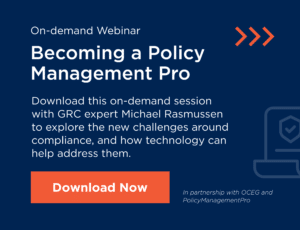Policy Management: Choosing the Right Data Privacy Software, Part 1
What features should a legal or compliance team or technology buyer look for in the various solutions that should be elements of an effective data privacy and information governance initiative?
Today’s data privacy compliance demands are increasingly becoming more commonplace and complex, requiring companies to consider software solutions to cope with unprecedented needs for data security and information governance.
New regulations and standards are largely being driven by public reaction to revelations about hacks, leaks, and other issues surrounding consumer data. This public pressure is a global trend and has fueled a growing demand for corporate transparency and accountability relating to how data is collected, stored, accessed and used.
- Even after GDPR, 45% of EU citizens still don’t feel confident in their internet privacy.
- 59% of UK consumers were skeptical about companies’ use of customer data in 2019; 46% said that if a company mishandled data, they would decide to not buy from that company.
- 62% of US consumers think their personal data is less secure today, that data collection poses more risks than benefits, and it’s not possible to go through daily life without being tracked.
Choosing the right data privacy software to address your specific business needs is a critical task. The right product will help you cut the costs of non-compliance and decrease the number of non-compliance incidents, while reducing the time spent managing the escalating amount of data, documentation, attestations and other tasks involved in a modern compliance program.
Handling compliance complexities
Where compliance gets complicated – and it’s not about to get any simpler for enterprises operating in multiple markets – software can help organizations that have operations in various jurisdictions or who need a privacy program that goes beyond a simple privacy policy. The best software solutions manage high volumes of complex, privacy management activities and are easy to use.
First, though? Making the proper choice among competing software solutions entails having a good grasp on your obligations, industry standards, and what data you collect, how you collect it, and how it’s stored. These factors will be central to deciding what types of software you need to deal with your enterprise’s particular challenges.
What to look for in data privacy software
There’s no single solution that can answer every sizable company’s data privacy needs, because those needs run the gamut from the technical to human factors, from oversight to operations. Buyers will find themselves evaluating individual products, each with multiple capabilities, to address different facets of data privacy protection and information governance.
In this series of posts, we’ll explore the key features and benefits you should look for from products that absolutely belong in your enterprise’s data privacy solutions suite.
Black hat boldness: In 2019, a collection of 2.7 billion identity records, consisting of 774 million unique email addresses and 21 million unique passwords, was posted for sale on the web.
Choosing software for Policy Management
The foundation of a solid data privacy program is built with policies and procedures based on meeting regulatory obligations, with an accountability mechanism embedded in them to promote employee compliance.
After all, employees are your biggest risk factor: according to Gartner, 59% of privacy incidents originate with an organization’s own employees.
Businesses need to be effective in creating a Policy Management framework that offers turnkey processes that can save time, money, frustration – and avoiding or reducing litigation and reputational brand damage due to policy breaches. The right Policy Management software makes that far more feasible.
What capabilities should you search for?
- A good Policy Management software solution will, first of all, provide multiple and up-to-date supporting document templates to allow your staff to create what’s required for a data privacy program. Automating the creation and update approval process for policies and procedures will help with workflow delays.
- Employee understanding of policies and procedures is essential, but information overload can be a major roadblock to employee adoption of compliant behaviors. One way to ensure your employees get the information they need to remain compliant is to target the right segments of your workforce with only the information that’s appropriate to each of them, in the right language.
Jonathan Spira, CEO and chief analyst at Basex, a knowledge economy research firm, said “information overload costs the U.S. economy a minimum of $900 billion per year in lowered employee productivity and reduced innovation.” The best policy management tools allow for targeted distribution of information, with the capability for end users to easily retrieve policies when needed.
- Your ability to assess and optimize your compliance program should be streamlined, too; the right solution should allow you to track attestations within your program, and make any changes required to improve compliance.
- Furthermore, having the ability to automate reporting to enable early risk assessments and responses will reduce the number and cost of regulatory non-compliance incidents.
- Ease of use is practically paramount, so both administrators and employees alike are able to work with the solution with minimal (or even no) training. This is important because most employees have difficulty with data privacy and cybersecurity issues; 75% of respondents in one survey struggled to understand any best practices in these areas, marking them at the “novice” or “risk” level.
[bctt tweet=”Information overload costs the U.S. economy a minimum of $900 billion per year in lowered employee productivity and reduced innovation.” via=”yes”]



